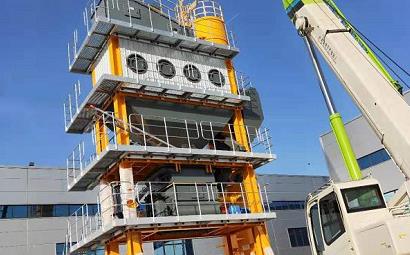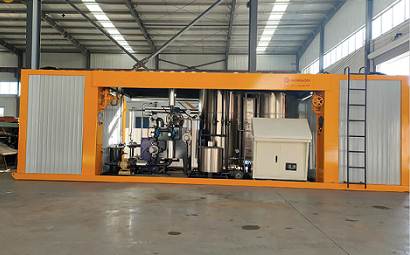1. Preparation for construction
First of all, the testing of raw materials must meet technical standard requirements. The metering, mixing, traveling, paving and cleaning systems of the slurry sealing machine should be prevented, debugged and calibrated. Secondly, the diseased areas of the construction pavement must be thoroughly investigated and dealt with in advance to ensure that the original road surface is smooth and complete. Ruts, pits, and cracks must be dug and filled before construction.
2. Traffic management
In order to ensure the safe and smooth passage of vehicles and the smooth operation of construction. Before construction, it is necessary to first negotiate with the local traffic control and law enforcement departments on the traffic closure information, set up construction and traffic safety signs, and assign traffic management personnel to manage the construction to ensure the safety of the construction.
3. Road cleaning
When performing micro-surfacing treatment on a highway, the highway road surface must first be thoroughly cleaned, and the road surface that is not easy to clean must be flushed with water, and construction can only be carried out after it is completely dry.


4. Staking out and marking lines
During construction, the full width of the road must be accurately measured to adjust the width of the paving box. In addition, most of the plural numbers during construction are integers, so the guide lines for marking conductors and sealing machines must be consistent with the construction boundary lines. If there are original lane lines on the road surface, they can also be used as auxiliary references.
5. Paving of micro surface
Drive the modified slurry sealing machine and the sealing machine loaded with various raw materials to the construction site, and place the machine in the correct position. After the paver box is adjusted, it must conform to the curvature and width of the paved road surface. At the same time, it is necessary to organize it according to the steps to adjust the thickness of the paved road. Secondly, turn on the switch of the material and let the material be stirred in the mixing pot so that the aggregate, water, emulsion and filler inside can be well blended in equal proportions. After mixing thoroughly, pour into the paving box. In addition, it is necessary to observe the mixing consistency of the mixture and adjust the water volume so that the slurry can meet the needs of road paving in terms of mixing. Again, when the paving volume reaches 2/3 of the mixed slurry, turn on the button of the paver and move forward on the highway at a constant speed of 1.5 to 3 kilometers per hour. But keep the slurry spreading volume consistent with the production volume. In addition, the volume of the mixture in the paving box must be about 1/2 during work. If the temperature of the road surface is very high or the road surface is dry during work, you can also turn on the sprinkler to moisten the road surface.
When one of the spare materials in the sealing machine is used up, the automatic operation switch must be quickly turned off. After all the mixture in the mixing pot is spread, the sealing machine must immediately stop moving forward and raise the paving box. , then drive the sealing machine out of the construction site, rinse the materials in the box with clean water, and continue the loading work.
6. Crush
After the road is paved, it must be rolled with a pulley roller that breaks the asphalt emulsification. Generally, it can start thirty minutes after paving. The number of rolling passes is about 2 to 3. During rolling, the strong radial bone material can be fully squeezed into the newly paved surface, enriching the surface and making it more dense and beautiful. In addition, some loose accessories must also be cleaned up.
7.Initial maintenance
After the micro-surface construction is carried out on the highway, the emulsification formation process at the sealing layer should keep the highway closed to traffic and prohibit the passage of vehicles and pedestrians.
8Open to traffic
After the micro-surfacing construction of the highway is completed, all traffic control signs must be removed to open the road surface, leaving no obstacles to ensure smooth passage of the highway.
 Albanian
Albanian  Russian
Russian  Arabic
Arabic  Amharic
Amharic  Azerbaijani
Azerbaijani  Irish
Irish  Estonian
Estonian  Odia (Oriya)
Odia (Oriya)  Basque
Basque  Belarusian
Belarusian  Bulgarian
Bulgarian  Icelandic
Icelandic  Polish
Polish  Bosnian
Bosnian  Persian
Persian  Afrikaans
Afrikaans  Tatar
Tatar  Danish
Danish  German
German  French
French  Filipino
Filipino  Finnish
Finnish  Frisian
Frisian  Khmer
Khmer  Georgian
Georgian  Gujarati
Gujarati  Kazakh
Kazakh  Haitian Creole
Haitian Creole  Korean
Korean  Hausa
Hausa  Dutch
Dutch  Kyrgyz
Kyrgyz  Galician
Galician  Catalan
Catalan  Czech
Czech  Kannada
Kannada  Corsican
Corsican  Croatian
Croatian  Kurdish (Kurmanji)
Kurdish (Kurmanji)  Latin
Latin  Latvian
Latvian  Lao
Lao  Lithuanian
Lithuanian  Luxembourgish
Luxembourgish  Kinyarwanda
Kinyarwanda  Romanian
Romanian  Malagasy
Malagasy  Maltese
Maltese  Marathi
Marathi  Malayalam
Malayalam  Malay
Malay  Macedonian
Macedonian  Maori
Maori  Mongolian
Mongolian  Bengali
Bengali  Myanmar (Burmese)
Myanmar (Burmese)  Hmong
Hmong  Xhosa
Xhosa  Zulu
Zulu  Nepali
Nepali  Norwegian
Norwegian  Punjabi
Punjabi  Portuguese
Portuguese  Pashto
Pashto  Chichewa
Chichewa  Japanese
Japanese  Swedish
Swedish  Samoan
Samoan  Serbian
Serbian  Sesotho
Sesotho  Sinhala
Sinhala  Esperanto
Esperanto  Slovak
Slovak  Slovenian
Slovenian  Swahili
Swahili  Scots Gaelic
Scots Gaelic  Cebuano
Cebuano  Somali
Somali  Tajik
Tajik  Telugu
Telugu  Tamil
Tamil  Thai
Thai  Turkish
Turkish  Turkmen
Turkmen  Welsh
Welsh  Uyghur
Uyghur  Urdu
Urdu  Ukrainian
Ukrainian  Uzbek
Uzbek  Spanish
Spanish  Hebrew
Hebrew  Greek
Greek  Hawaiian
Hawaiian  Sindhi
Sindhi  Hungarian
Hungarian  Shona
Shona  Armenian
Armenian  Igbo
Igbo  Italian
Italian  Yiddish
Yiddish  Hindi
Hindi  Sundanese
Sundanese  Indonesian
Indonesian  Javanese
Javanese  Yoruba
Yoruba  Vietnamese
Vietnamese  Hebrew
Hebrew  Chinese (Simplified)
Chinese (Simplified)







